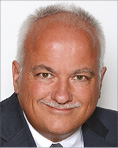
If you were in Barcelona at the end of August there is no need for me to remind you of how exciting this year’s annual scientific session of our parent organisation, the European Society of Cardiology, was. For the EAPCI to participate in this fruitful and dynamic meeting is a challenge and a pleasure – and this year to have interventional cardiology as such an integral part of the programme was, in addition, indeed an honour. Since it was founded in 1950, the constant evolution, interest and impact of the ESC have been impressive and are based on the hard work, rigour and active commitment of all its members. The work of this organisation is a natural extension of the work of our association – as individual clinicians and researchers – in offering the best cardiovascular care possible. With over 30,000 attendees from 140 countries, ESC Barcelona 2017 was very much the centre of cardiology worldwide.
While this year, by any standard, was an important one, with many new guidelines and breaking research being presented, it was especially noteworthy for the EAPCI as we marked the 40th anniversary of angioplasty. This was further celebrated by the ESC itself, which had for its special theme this year “Spotlight 2017: 40 Years of PCI”. The superb travelling exhibit on 40 years of coronary angioplasty that premiered at EuroPCR 2017 in Paris last May was also a resounding success in Barcelona. There was something poignant about the many young (and not so young) fellow specialists who chose to have their photos taken in front of one of the exhibit’s panels, reminding us that this walk through the history of our specialty can inspire present –and future– practitioners. Further, the opportunity of being an official part of the ESC programme provided us with a wide range of official and dedicated sessions offered by leading interventional cardiologists presenting not only the seminal work of pioneers such as Andreas Grüntzig, but also the state of the art in interventional practice today.
We have spoken about the importance of this anniversary in recent editions of EuroIntervention. As this edition of EuroIntervention goes to press, PCR London Valves 2017 will have just ended where, among other things, we will have celebrated the 15th anniversary of the first transcatheter valve implantation. We have spoken about all these milestones in earlier issues of the journal and, while we understand that the past is an essential building block for future practice, our goal and that of the ESC is to look resolutely towards the future, while seeing where and how we practise today.
This is evident in the constantly evolving guidelines produced by the ESC, many of which were released around the time of the ESC meeting. This year these included new ones such as the 2017 ESC focused update on dual antiplatelet therapy (DAPT); the joint ESC/EACTS guidelines for the management of valvular heart disease (VHD); the ESC Guidelines on acute myocardial infarction in patients presenting with ST-segment elevation (STEMI), and the ESC/ESVS guidelines for the diagnosis and treatment of peripheral arterial diseases (PAD).
Among the 40 late-breaking scientific presentations, during the dedicated “Late-Breaking Science – Hot Line Sessions”, we were presented with recent data from such trials as:
– COMPASS – two presentations, the first looking at cardiovascular outcomes for people using anticoagulation strategies, and the second the results in patients with coronary artery disease and in patients with peripheral artery disease.
– In hypertension there was the SPYRAL HTN OFF-MED study, concerning the “assessment of the efficacy and safety of renal denervation in the absence of antihypertensive medications”.
– There were also updates on DAPT use in the long-term follow-up of the NIPPON trial, looking at “the long-term efficacy and safety of short dual antiplatelet therapy”.
– Results from the ALBATROSS trial (Aldosterone Lethal effects Blockade in Acute myocardial infarction Treated with or without Reperfusion to improve Outcome and Survival at Six months follow-up).
– GLAGOV, looking at the effect of the PCSK9 inhibitor, evolocumab, on the composition of coronary atherosclerosis.
– EARLY-BAMI results – the one-year clinical outcome of early administration of intravenous beta-blockers in patients with ST-elevation myocardial infarction before primary percutaneous coronary intervention.
Registries were represented in late-breaking registry sessions including:
– The CHANGE DAPT registry on clopidogrel or ticagrelor in ACS patients treated with newer-generation drug-eluting stents.
– Additional data from SCAAR looking at whether pretreatment with P2Y12 receptor antagonists is not associated with improved clinical outcomes in STEMI.
– MAUDE, focusing on leaflet thrombosis following transcatheter aortic valve replacement.
– A registry looking at whether implementation of modern treatments explains improvements in outcomes after STEMI over a 20-year period in Sweden from 1995 to 2014.
Clearly this is little more than a birds-eye view of the meeting itself.
Over the next few months – and even in this current issue – many of these important topics will be covered in detail. Looking across the broad sweep of subjects covered during the ESC annual meeting, it is evident that integration of our association within the umbrella organistion of the ESC can –and is– having a direct and positive impact on our own activities. Clearly, by working together we enhance the depth, breadth and quality of our research and our clinical practice in order to offer the best possible care to all.

